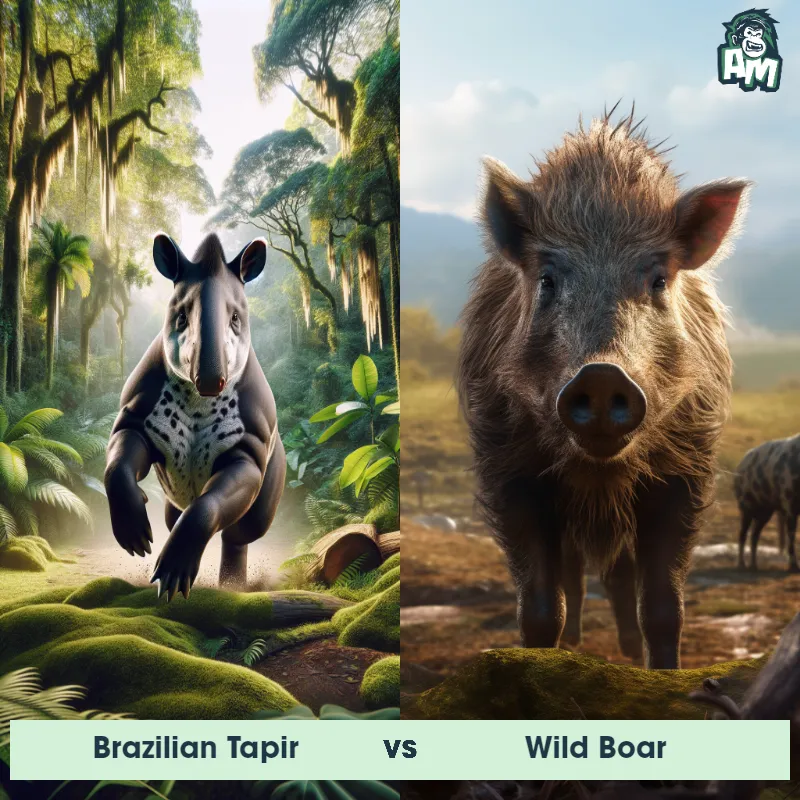The Brazilian Tapir
The Brazilian Tapir, also known as the lowland tapir, is a large herbivorous mammal that inhabits the forests and grasslands of Brazil and other South American countries. It is characterized by its stout body, short legs, and distinctive trunk-like snout. The tapir's thick and smooth fur varies in color from dark brown to grayish-black, providing excellent camouflage in its natural habitat. It has a stocky build, weighs around 600 to 800 pounds, and measures about 6 to 8 feet in length. The Brazilian Tapir is known for its solitary nature and mainly feeds on leaves, fruits, and aquatic vegetation.

| Brazilian Tapir | |
|---|---|
| Size | Average length 1.8-2.5 meters (5.9-8.2 feet) |
| Weight | Around 200-250 kilograms (440-550 pounds) |
| Speed | 30mph (48km/h) |
| Key Strength | Powerful bite |
| Biggest Weakness | Limited mobility |
| Scientific Name | Tapirus terrestris |
| Family | Tapiridae |
| Habitat | Tropical rainforests |
| Geography | Brazil, South America |
| Diet | Herbivorous |
| Lifespan | 20 years - 30 years |

The Brazilian Tapir
The Brazilian Tapir, also known as the lowland tapir, is a large herbivorous mammal that inhabits the forests and grasslands of Brazil and other South American countries. It is characterized by its stout body, short legs, and distinctive trunk-like snout. The tapir's thick and smooth fur varies in color from dark brown to grayish-black, providing excellent camouflage in its natural habitat. It has a stocky build, weighs around 600 to 800 pounds, and measures about 6 to 8 feet in length. The Brazilian Tapir is known for its solitary nature and mainly feeds on leaves, fruits, and aquatic vegetation.
Fun Fact: The Brazilian Tapir has an incredible ability to swim underwater, using its long, flexible snout as a snorkel to breathe while submerged, allowing it to move stealthily through rivers and lakes.
| Brazilian Tapir | |
|---|---|
| Size | Average length 1.8-2.5 meters (5.9-8.2 feet) |
| Weight | Around 200-250 kilograms (440-550 pounds) |
| Speed | 30mph (48km/h) |
| Key Strength | Powerful bite |
| Biggest Weakness | Limited mobility |
| Scientific Name | Tapirus terrestris |
| Family | Tapiridae |
| Habitat | Tropical rainforests |
| Geography | Brazil, South America |
| Diet | Herbivorous |
| Lifespan | 20 years - 30 years |
Brazilian Tapir Matchups
We use AI to simulate matchups between the Brazilian Tapir and other animals. Our simulation considers size, strength, and natural predatory behaviors to determine the most likely outcome.

Can't find the Matchup you want?
Create Your Own MatchupBrazilian Tapir: Diet, Predators, Aggression, and Defensive Behaviors
What do Brazilian Tapirs eat?
Brazilian Tapirs are herbivores, mainly feeding on leaves, aquatic plants, fruits, and grasses. They are known to browse along riverbanks and in forests for their food. Their diet also consists of shoots, buds, and small branches.
Do Brazilian Tapirs have any predators?
Brazilian Tapirs have few natural predators in the wild. Jaguars and large predators such as anacondas are known to prey on them. Tapirs are often hunted by humans for their meat and hides, posing a significant threat to their population.
Are Brazilian Tapirs aggressive?
Brazilian Tapirs are usually peaceful and shy animals, not known for their aggressiveness. They tend to avoid confrontation with other animals and humans, preferring to escape rather than fight. However, they may become defensive if they feel threatened or cornered.
Do Brazilian Tapirs fight?
While Brazilian Tapirs do not actively seek out fights, they may engage in physical conflicts when defending themselves or their territory. They use their powerful jaws and sharp teeth to defend against threats, but they are more likely to flee than fight.
How do Brazilian Tapirs defend themselves?
Brazilian Tapirs primarily rely on their excellent sense of smell, hearing, and camouflage to avoid danger. When threatened, they may emit loud vocalizations to warn intruders or use their agility to escape predators. In rare cases, they can deliver strong bites to defend themselves from attackers.
What is the Brazilian Tapir's biggest weakness in a fight?
The Brazilian Tapir's biggest weakness in a fight is its relatively slow speed compared to some predators. While they are good swimmers and agile on land, their escape mechanisms rely more on evasion than direct confrontation. This vulnerability makes them susceptible to faster predators like jaguars in certain situations.
Fun Fact: The Brazilian Tapir plays an important ecological role as a seed disperser. After consuming various fruits, it defecates the undigested seeds in different locations, helping in the dispersal of plant species and contributing to forest regeneration.
Fun Fact: Despite its relatively large size, the Brazilian Tapir possesses a keen sense of hearing and smell, making up for its relatively poor eyesight. This sharp sensory awareness helps the tapir detect potential threats and predators in its environment, aiding in its survival.












